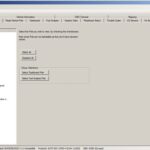OBDII code P0172 indicates a lean condition in the engine, meaning there’s too much air compared to fuel in the air-fuel mixture. This can lead to poor performance, reduced fuel economy, and potential engine damage. Several factors can contribute to a P0172 code, ranging from simple vacuum leaks to faulty sensors. This article will guide you through common causes and troubleshooting steps for OBDII code P0172.
Common Causes of OBDII Code P0172
A lean condition can stem from various issues within the engine system. Here are some of the most frequent culprits:
-
Vacuum Leaks: One of the primary causes of a P0172 code is a vacuum leak. Unmetered air entering the engine disrupts the air-fuel ratio, leading to a lean mixture. Common sources of vacuum leaks include cracked or damaged vacuum hoses, faulty PCV valves, and intake manifold gaskets.
-
Faulty Oxygen Sensor (O2 Sensor): The upstream oxygen sensor, located before the catalytic converter, plays a crucial role in monitoring the air-fuel ratio. A malfunctioning O2 sensor can provide inaccurate readings to the engine control module (ECM), causing it to incorrectly adjust the fuel mixture.
-
Mass Airflow Sensor (MAF) Issues: The MAF sensor measures the amount of air entering the engine. A dirty or faulty MAF sensor can underestimate the airflow, resulting in a lean condition.
-
Fuel System Problems: Issues within the fuel system, such as a clogged fuel filter, weak fuel pump, or malfunctioning fuel injectors, can restrict fuel flow and contribute to a lean mixture. Low fuel pressure can also trigger a P0172 code.
-
Other Potential Causes: Less common causes can include a faulty engine coolant temperature sensor, problems with the exhaust gas recirculation (EGR) system, or even a leaking intake manifold gasket.
Troubleshooting OBDII Code P0172
Diagnosing and fixing a P0172 code requires a systematic approach:
-
Inspect for Vacuum Leaks: Start by thoroughly inspecting all vacuum hoses and connections for cracks, damage, or loose fittings. Use a vacuum gauge or smoke machine to pinpoint leaks. Pay particular attention to the PCV valve and its associated hoses.
-
Test the Oxygen Sensor: Using a multimeter or a scan tool, test the upstream oxygen sensor’s voltage readings. Compare the readings to manufacturer specifications to determine if the sensor is functioning correctly.
-
Clean or Replace the MAF Sensor: Carefully clean the MAF sensor using a specialized MAF sensor cleaner. If cleaning doesn’t resolve the issue, consider replacing the sensor.
-
Check Fuel Pressure: Verify that the fuel pressure is within the manufacturer’s recommended range. A fuel pressure gauge can be used to accurately measure the pressure.
-
Inspect Fuel System Components: Check the fuel filter for clogs and replace it if necessary. If fuel pressure is low, diagnose the fuel pump and fuel injectors for proper operation.
Conclusion
Addressing OBDII code P0172 involves identifying and resolving the underlying cause of the lean condition. By systematically inspecting and testing key components, you can effectively diagnose and fix the issue, restoring proper engine performance and fuel efficiency. If you’re not comfortable performing these tasks yourself, consult a qualified mechanic for assistance. Ignoring a P0172 code can lead to more serious engine problems down the road.

